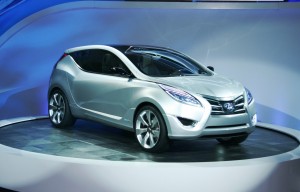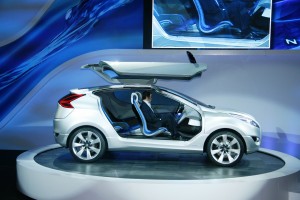
The innards of Nuvis contain a hybrid powertrain system that the company has big plans for in its quest to surpass the reputation of Japanese automakers as the proven Oriental innovators.
Eleven and counting. That’s how Hyundai bills its Nuvis concept that debuted at the 2009 New York International Auto Show. That is, Nuvis is the eleventh concept vehicle that was designed at the company’s California Design Center in Irvine. While the exterior and interior styling cues are, perhaps, indicators of the Korean brand’s next crossover vehicle, what really counts is what’s underneath all the show car hype and glitz.
The innards of Nuvis contain a hybrid powertrain system that the company has big plans for in its quest to surpass the Japanese as the proven Oriental innovators. Hyundai has said it will best all competing automakers in North American fuel economy by 2015, a bold statement from what was once a company that purveyed older, discarded Japanese designs. (But then who thought Hyundai could ever overcome its well deserved reputation for poor quality from its first generation of U.S. compact offerings that debuted back in the 1980s?) Still, a Toyota Prius with 50 mpg on the EPA window sticker when it debuts next month is an ambitious, critics would say, unobtainable target.
So this quest comes down to Hyundai’s “all-new,” Korean designed “Hybrid Blue Drive architecture” that will really define the Nuvis as a successful concept or just another quickly forgotten helping of Asian fast food. Unfortunately little of the technical detail needed to judge whether Hyundai’s rear-drive parallel hybrid drive system is sophisticated enough to run with the proven, pacesetting Toyota technology.
What is known is encouraging, but it hardly stands as a breakthrough: a relatively fuel-efficient 2.4-liter engine is combined with a 6-speed automatic transmission and a 30kW (205 N-m) electric motor to maximize fuel economy. Hybrid Blue Drive has an all-electric mode and a parallel drive mode, meaning that the wheels are turned by power coming directly from the gasoline engine, or the electric motor, or both together, as conditions demand. This parallel hybrid setup will be foundation for future Hyundai hybrid drive vehicles, starting with the next-generation Sonata in the United States.

Nuvis looks good. Things will get more interesting when the Elantra LPI Hybrid, goes on sale in Korea this July and actual driving commences.
Engine management software automatically shuts off the engine when the vehicle comes to a halt, cutting emissions to zero. The engine automatically restarts when pressure is reapplied to the accelerator pedal due to the Integrated Starter Generator (ISG). To further reduce fuel consumption, the software, which governs fuel injection pressure, engine cycle timing and exhaust gas recycling rates, is revised for the hybrid.
This “control strategy” assures that maximum efficiency is achieved during gentle acceleration, while greater power is immediately available during full acceleration, according to Hyundai. During deceleration, regenerative braking is also used to increase efficiency. To ensure that the engine itself runs at lower speeds, the top three gear ratios in the transmission have been extended. Fuel economy is further optimized through an electric motor-assisted steering system which reduces power drain. Low rolling resistance tires are also used. Again, this all is conventional hybrid thinking.
What is unconventional and potentially a breakthrough is a lithium polymer battery package, with 5.3 Ah of capacity at 270 volts. This is not the lithium ion type of design that set Sony laptop computers ablaze and led to a couple of well publicized recalls. Aside from the potential safety benefits, it remains to be seen whether the batteries are affordable, and have sufficient life and the ability to provide power and receive it at fast enough rates for an automobile that operates under a variety of conditions.
Nuvis looks good on an auto show display, things will get more interesting this July when Hyundai’s first hybrid car, the Elantra LPI Hybrid, goes on sale in Korea and actual driving commences.
